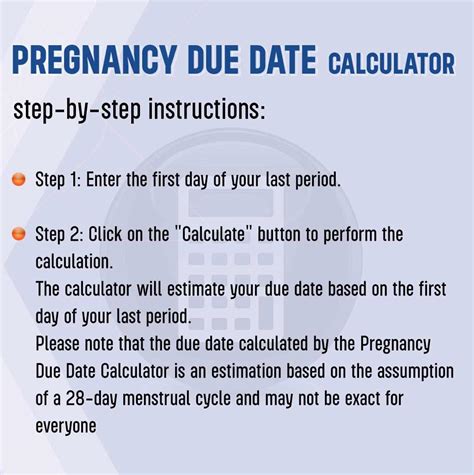Intro
Calculating due dates is an essential skill in various aspects of life, including business, education, and personal planning. Whether you're managing projects, expecting a baby, or simply trying to meet deadlines, understanding how to calculate due dates can help you stay organized and on track. In this article, we'll delve into the world of due date calculations, exploring the importance of accurate timing and providing you with the tools and techniques to make calculations easier.
The ability to calculate due dates accurately is crucial in many industries. For instance, in construction, missing a deadline can lead to significant financial losses and damage to a company's reputation. Similarly, in the medical field, calculating the due date of a pregnancy is vital for prenatal care and preparing for the arrival of a newborn. By mastering due date calculations, individuals can better plan, manage their time more efficiently, and reduce stress associated with uncertainty.
Calculating due dates involves understanding the concept of time intervals and how to apply them to different scenarios. It requires a basic understanding of calendar systems, including days of the week, months, and years. Additionally, being familiar with calculators or software that can perform date calculations can be incredibly helpful. With the advancement of technology, there are numerous tools and apps available that can simplify the process of calculating due dates, making it more accessible to a wider audience.
Understanding Due Date Calculations

To calculate a due date, you need to determine the start date of a project or event and the duration or timeframe in which it needs to be completed. This can be applied to pregnancies, where the due date is calculated from the first day of the last menstrual period (LMP), assuming a regular 28-day menstrual cycle and ovulation occurring on day 14. For projects, the start date might be when the project begins, and the duration could be based on the complexity of the task, the number of team members, and the available resources.
Calculating Pregnancy Due Dates
Calculating the due date of a pregnancy is a common application of due date calculations. The most common method used is Naegele's rule, which involves adding 7 days to the first day of the last menstrual period and then adding 9 months. This rule provides an estimated due date, which can then be refined with ultrasound scans. Understanding how to calculate a pregnancy due date can help expectant mothers prepare for the arrival of their baby and make necessary arrangements.Methods for Calculating Due Dates

There are several methods and tools available for calculating due dates, ranging from manual calculations using calendars and calculators to automated software and apps. The choice of method often depends on the context and the desired level of accuracy. For personal use, a calendar or a pregnancy due date calculator app might suffice. In professional settings, especially in project management, specialized software like Microsoft Project or Asana can be used to set deadlines and track progress.
Using Technology for Due Date Calculations
Technology has significantly simplified the process of calculating due dates. Online calculators and mobile apps can instantly provide a due date based on the input of a start date and duration. These tools often account for weekends, holidays, and other non-working days, making them particularly useful for business and project management applications. Furthermore, digital calendars can send reminders and notifications, helping individuals stay on track and meet their deadlines.Benefits of Accurate Due Date Calculations

Accurate due date calculations offer numerous benefits. They enable better planning, allowing individuals and organizations to allocate resources more effectively and manage expectations. In healthcare, accurate due date calculation is critical for providing appropriate prenatal care and ensuring that mothers and babies receive the necessary medical attention at the right time. In business, meeting deadlines can enhance reputation, lead to customer satisfaction, and result in financial gains.
Common Challenges in Due Date Calculations
Despite the advancements in calculation methods and tools, challenges still exist. In project management, unforeseen delays or changes in project scope can affect due dates. In pregnancy calculations, irregular menstrual cycles or the inability to recall the exact date of the last menstrual period can lead to inaccuracies. Addressing these challenges requires flexibility, the ability to adjust plans, and sometimes, seeking professional advice.Best Practices for Due Date Management

Effective due date management involves several best practices. Setting realistic deadlines, breaking down large projects into smaller tasks, and regularly reviewing progress can help in meeting deadlines. Communicating clearly with team members or stakeholders about due dates and any changes is also crucial. Additionally, building in buffers for unexpected delays and maintaining a flexible approach to project management can reduce stress and improve outcomes.
Tools and Resources for Due Date Calculations
There are numerous tools and resources available for calculating and managing due dates. Online calculators, project management software, and mobile apps are designed to simplify the process, offer reminders, and track progress. For pregnancies, healthcare providers often use ultrasound scans to confirm due dates calculated by Naegele's rule or other methods. In business, tools like Gantt charts and calendars are invaluable for visualizing project timelines and setting achievable milestones.Conclusion and Future Directions

In conclusion, calculating due dates is a vital skill that applies to various aspects of life. From pregnancies to project management, understanding how to accurately calculate and manage due dates can lead to better planning, reduced stress, and improved outcomes. As technology continues to evolve, we can expect even more sophisticated tools and methods for due date calculations, further simplifying the process and enhancing accuracy.
Final Thoughts on Due Date Calculations
As we move forward, embracing technology and best practices in due date management will be key to success. Whether you're an expectant mother, a project manager, or simply someone looking to improve your time management skills, mastering due date calculations can make a significant difference. By staying informed, utilizing the right tools, and adopting a flexible approach to planning, you can navigate the complexities of due dates with confidence.
We invite you to share your experiences and tips on calculating and managing due dates. Your insights can help others in their journey to master this essential skill. Feel free to comment below, and don't forget to share this article with anyone who might benefit from understanding the importance and methods of due date calculations.
What is the most common method for calculating pregnancy due dates?
+Naegele's rule is the most common method, which involves adding 7 days to the first day of the last menstrual period and then adding 9 months.
How can technology aid in due date calculations?
+Technology, including online calculators, mobile apps, and project management software, can simplify due date calculations, account for non-working days, and provide reminders and notifications.
What are the benefits of accurate due date calculations?
+Accurate due date calculations enable better planning, resource allocation, and time management, leading to reduced stress, improved outcomes, and enhanced reputation in professional settings.
